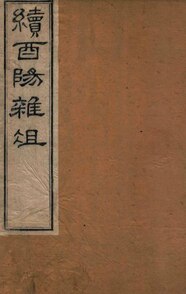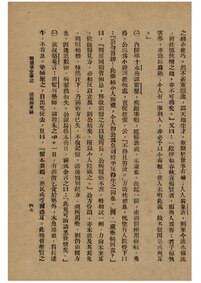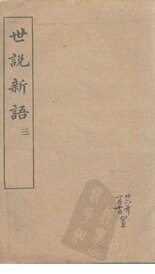Biji (Chinese literature)
Biji(Chinese:Bút ký) is a special literary genre in classicalChinese literature.Literally "notebook"or" written notes ".[1][2]There is no strict writing mode forbiji,[3]it is a literary form mainly based on recording personal insights, experiences, miscellaneous sensations, and trifles, and it is known for its characteristics of scattered notes and trivial records. A book ofbijican contain stories, anecdotes, quotations, random musings, philological speculations, literary criticism and indeed everything that the author deems worth recording.
Genre and evolution
[edit]The genre a long history back to the early tradition of 'notes on the strange' (zhiguai) in the Wei-Jinperiod (3rd to 4th centuries A.D.),[4]and matured during theTang dynasty.From the Wei-Jin to Tang Dynasties, the Chinese produced many great biji which organized ancient knowledge of myriad things in patterns that are far different from the more orthodox Song biji.[4]The Wei,Jin,Northern and Southern Dynastieswas a period of political division in Chinese history, and also an era of flourishing culture and art. During this time gave rise to various literary genres, includingbiji.Thebijiof that period of time mostly contains the believe-it-or-not kind of anecdotes, and many of them can be treated as collections ofshort fictions.To differentiate this kind of "biji fiction"from the generalbiji,the former is later calledbiji xiaoshuo( bút ký tiểu thuyết "notebook fiction" ).
Biji emerged as an independent literary genre during theSouthern Dynasties(420 to 589) and underwent further refinement during theTang Dynasty(618 to 907).[3]In addition, theSong Dynasty,known for its extended period of peace in Chinese history, saw stable social and economic development. This stability contributed to a prosperous environment, fostering the flourishing ofbijiliterature during the dynasty's reign from 960 to 1279.[3]Historiographic themes hold significant importance in thebijitext of the Song dynasty. Therefore, they serve as crucial resources for the study of Song history. Many works of which adopting an "item-by-item style and stipulated no further rules for the size, structure, or mutual relations of these items", and continued to flourish during the later dynasties up until the end of the 19th century.[1]According to Ronald Egan, thebijias a genre "served as an alternative to the classical commentary and the formal essay" in traditional Chinese letters and allowed writers to record their reflections or scholarly insights freely.[2]
Characteristics and Style
[edit]Bijiis a type of text divided into several categories or sections, known as "Juan" in Chinese.[3]Unlike traditional narrative structures that follow a chronological sequence and include clear beginnings, developments, and endings,Bijiliterature emphasises personal observations, feelings, and reflections.[5]It often records genuine insights and experiences in daily life through the author's perspective and voice, narrating fragmented segments.[5]This form is characterised by its high flexibility and informality, representing a form of literature that is creative and expressive.[5]

Traditional literary genres such aspoetry,rhapsody,prose,andlyric poetryusually have specific themes and formal requirements. In contrast,bijiare often fragmented and episodic, lacking continuous narration or a unified theme, and are not constrained by formal literary structures.[5] In some instances, the various sections within abijiarticle may not have explicit headings or rules for classification. Readers, however, will discover an implicit organisational structure through attentive reading. Authors ofbijimostly jot down relatively incoherent descriptions and reflections during their leisure time, with each section possibly lacking clear titles and instead being indicated by numerical markers.[5]These sections or categories typically consist of numerous brief annotations, subsequently arranged and categorised based on thematic relevance.

Biji literature, as a significant literary genre, has showcased its unique characteristics and styles across different periods.[5]
Han Dynasty and the Wei, Jin, Northern, and Southern Dynasties
[edit]During the Han Dynasty and the Wei, Jin, Northern, and Southern Dynasties,bijiliterature not only recorded anecdotes but also reflected the social customs and personal insights of the time.[5]
Tang and Song Dynasties
In the Tang and Song Dynasties,bijiworks recorded daily trivia and personal experiences, highlighting individual emotions and experiences while reflecting the culture and customs of the society.[5]Bijiliterature from this period often focused on recording and describing, emphasising factual recording and textual criticism.[5]Authors expressed their observations of society, history, and nature through these notes. Many scholars produced works covering a wide range of themes, including personal life, natural scenery, historical events, and cultural landscapes. For instance, the Tang Dynasty'sbijiliterature, such as "Miscellaneous Morsels from Youyang( Dậu Dương Tạp Trở ),"contains numerous records of anecdotes and strange events.[5]
Ming and Qing Dynasties

By the Ming and Qing Dynasties, the content ofbijiliterature included not only anecdotes but also aspects of politics, economy, and culture.[5]Bijiworks from these periods placed more emphasis on personalized expression and literary quality, featuring strong personal colour and literary creativity.[5]For example, the Ming Dynasty's "Notes of the Thatched Abode of Close Observations( duyệt hơi thảo đường bút ký )"became a representative work ofbijiliterature from this period due to its detailed records and vivid descriptions.
As a free-form literary genre,bijiliterature is an ideal medium for scholars to express their thoughts and record their lives.[5]
Influence and Legacy
[edit]Bijioccupies an important position in the Chinese literary tradition as a literary form.[6]Through the author's observations of daily life, social customs, and political events, it records key aspects of Chinese society, culture, and history across different periods, and is considered a valuable historical document.[2]It emphasises an informal style and subjective reflection, challenging traditional literary norms and allowing authors to express their thoughts and feelings more freely.[6]

The authors ofbijiare typically intellectuals, scholars, or literati who deeply engage with pressing social, political, and cultural issues of their time. Their works provide a platform for critical reflection, social commentary, and intellectual debate.[6]By incorporating innovative narrative and writing techniques such as essays and travel notes,bijiblends vivid scenes with profound thought, inspiring contemporary intellectuals and writers.Liu Yiqing's "A New Account of the Tales of the World"uses numerous short stories to reflect the social customs and political attitudes of the aristocratic class during theEastern Jin Dynasty,revealing the power structures and social ethos of the time.[6]Ji Yun's "Notes of the Thatched Abode of Close Observations"documents various social phenomena and political events of theQing Dynasty,providing critical reflections on social issues.[6]These works, through their diverse narrative techniques, reveal the social realities and political conditions of different periods, making them essential resources for studying Chinese history and culture.
As a part of the Chinese literary tradition,bijialong with genres likepoetry,prose,anddrama,collectively create a rich and colourful literary landscape.[6]Their artistic value and cultural significance have been highly praised, having a profound impact on the literary world and opening new possibilities for the development of contemporary literature.[6]
The diversity ofbijimakes it difficult to classify them into a specific literary genre, but this flexibility allowsbijito occupy a unique position in the history of Chinese literature.[6]They serve as a valuable means to understand the thoughts and social lives of ancient Chinese literati.
Notable works
[edit]- Miscellaneous Morsels from Youyang( Dậu Dương Tạp TrởYǒuyáng Zázǔ), byDuan Chengshi,Tang dynasty
- Dream Pool Essays( mộng khê bút đàmMèngxī Bǐtán) byShen Kuo,Song dynasty
- Notebooks from the Rong Study( dung trai tuỳ bútRóngzhāi Suíbǐ) byHong Mai,Song dynasty
- Little Notes on the Nature of Things( vật lý tiểu thứcWùlǐ Xiǎoshí) by Fang Yizhi,Ming dynasty
- Notes of the Thatched Abode of Close Observations( duyệt hơi thảo đường bút kýYuèwēi Cǎotáng Bǐjì) byJi Yun,Qing dynasty
- A New Account of the Tales of the World( Thế Thuyết Tân Ngữ Shìshuō Xīnyü) by Liu Yiqing,Northern and Southern dynasty
- Baopuzi( Bão Phác Tử Bàopǔzǐ) by Ge Hong, Eastern Jin dynasty
- Soushen Ji ( Sưu Thần Ký Sōushén Jì) by Gan Bao, Eastern Jin dynasty
- Taiping Guangji( Thái Bình Quảng Ký Tàipíng Guǎngjì), compiled by Li Fang et al., Song dynasty
- Ying giường Yicao ( huỳnh cửa sổ dị thảo Yíngchuāng Yìcǎo) by Qu Dajun, Qing dynasty
- Qingteng Shuwu Biji ( thanh đằng phòng sách bút ký Qīngténg Shūwū Bǐjì) by Wang Shizhen, Ming dynasty
- Little Notes on the Nature of Things ( vật lý tiểu thức Wùlǐ Xiǎoshí) by Fang Yizhi, Ming dynasty
- Strange Stories from a Chinese Studio( Liêu Trai Chí Dị Liáozhāi Zhìyì) by Pu Songling, Qing dynasty
- Zi Bu Yu( tử bất ngữ Zǐ Bù Yǔ) by Yuan Mei, Qing dynasty
Criticism and Studies
[edit]Bijiis a valuable resource for understanding cultural practices, social norms, and everyday life in historical China. It captures a wide range of information that formal historical records often overlook.[7]In recent years, there has been a renewed interest inbijiboth in China and internationally. Modern writers and scholars are exploringbiji’s potential to offer fresh perspectives on contemporary issues. The literary and artistic value ofbijiis often debated. Some scholars argue thatbiji’s fragmented and anecdotal nature detracts from its literary quality, while others appreciate its unique stylistic features and narrative diversity.[8]
Modern scholars have conducted in-depth research on thebijiliterature during the Ming and Qing dynasties, considering it to hold a significant position in the history of Chinese literature and profoundly influence later literary works. At the same time, they also re-interpret and evaluate the artistic achievements ofbijiliterature from the perspective of literary criticism. Some critics have pointed out thatbijimay be subject to the limitations of the narrator’s positions, biases, and experiences, thus potentially carrying subjective undertones, leading to a lack of objectivity and comprehensiveness in the works, and failing to fully reflect the true aspects of society, culture, and history.[9]In addition, biji works are often fragmented, lacking the coherence and integrity of works. Compared with traditional literary forms,bijimay be relatively simple regarding literary skills and artistry, potentially lacking depth in the works. Due to their emphasis on realism and documentation, they may sacrifice literary imagination and creativity.
See also
[edit]References
[edit]- ^abZuo, Ya (2018).Shen Gua's Empiricism.Harvard University Asia Center. pp. 173–174.ISBN978-0-674-98711-1.
- ^abcQian, Zhongshu (1998). "Introduction".Limited Views: Essays on Ideas and Letters.Translated by Ronald, Egan. Harvard University Asia Center. p. 12.ISBN978-0-674-53411-7.
- ^abcdTheobald, Ulrich."biji bút ký ( chinaknowledge.de)".chinaknowledge.de.Retrieved2024-05-08.
- ^abDaiwie, Fu (2007). "The Flourishing of Biji or Pen-Notes Texts and its Relations to History of Knowledge in Song China (960-1279)".Extrême-Orient Extrême-Occident.1:103–130.doi:10.3406/oroc.2007.1071.JSTOR42635796.
- ^abcdefghijklmDenecke, Wiebke; Li, Wai-yee; Tian, Xiaofei (2017).The Oxford Handbook of Classical Chinese Literature (1000 BCE-900 CE).Oxford University Press.ISBN978-0-19-935659-1.
- ^abcdefghCai, Zong-qi (November 2020). "The Art of Chinese Prose: A Critical Introduction".Journal of Chinese Literature and Culture.7(2): 339–381.doi:10.1215/23290048-8745658.
- ^Liu, Jianjun (2018). "Cultural Memory and Historical Narrative in Biji Literature".East Asian History.63(4): 315–333.
- ^Wang, Liming (2020). "The Artistic Value of Biji: Fragmentation and Narrative Innovation".Journal of East Asian Literary Studies.22(1): 85–102.
- ^Liu, Gang (2010).The Poetics of Miscellaneousness: The Literary Design of Liu Yiqing's Qiantang Yishi and the Historiography of the Southern Song(Thesis).hdl:2027.42/78791.OCLC894435924.ProQuest849306935.[page needed]
